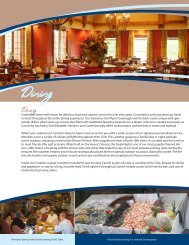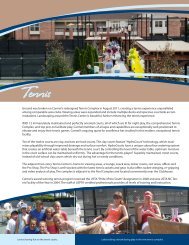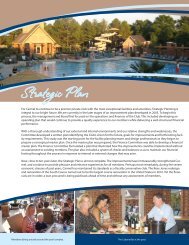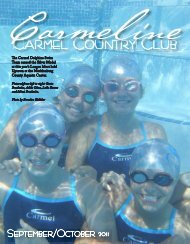to open the November 2011 Club - Carmel Country Club
to open the November 2011 Club - Carmel Country Club
to open the November 2011 Club - Carmel Country Club
You also want an ePaper? Increase the reach of your titles
YUMPU automatically turns print PDFs into web optimized ePapers that Google loves.
COURSE & GROUNDS<br />
<strong>Carmel</strong> CC turned a major disruption of its South Course in<strong>to</strong> a striking renovation that<br />
not only features a neoclassic design by Rees Jones but has changed <strong>the</strong> property’s<br />
maintenance practices—and <strong>the</strong> way its golfers play <strong>the</strong> game.<br />
By Betsy Gilliland, Contributing Edi<strong>to</strong>r<br />
At most golf course facilities, installation of a 7,000-linearfoot,<br />
six-foot-diameter municipal sewer line that had <strong>to</strong><br />
run 25 feet underground through <strong>the</strong> length of <strong>the</strong> property<br />
would be a major headache. At <strong>Carmel</strong> <strong>Country</strong> <strong>Club</strong> in<br />
Charlotte, N.C., that problem was seen as an opportunity for a<br />
complete overhaul of its 18-hole South Course.<br />
Because <strong>the</strong> sewer line project was going <strong>to</strong> shut it down<br />
anyway, <strong>the</strong> disruption offered <strong>the</strong> perfect chance <strong>to</strong> upgrade<br />
<strong>the</strong> South Course’s design, notes Certified Golf Course Superintendent<br />
Bill Anderson, <strong>Carmel</strong>’s Direc<strong>to</strong>r of Greens and<br />
Grounds. After approval <strong>to</strong> renovate <strong>the</strong> course was given,<br />
however, <strong>the</strong>re was one more decision <strong>to</strong> make.<br />
“The choice was <strong>to</strong> renovate small—or renovate big,” says<br />
John Schultz, CCM, <strong>Carmel</strong>’s General Manager.<br />
‘Never-Ending Pleasure’<br />
Ra<strong>the</strong>r than merely adding some shaping <strong>to</strong> <strong>the</strong> course, rebuilding<br />
<strong>the</strong> greens and replacing cart paths for $5 million,<br />
Schultz reports, <strong>Carmel</strong> decided <strong>to</strong> go big. The club, which had<br />
first approached renowned architect Rees Jones about renovating<br />
<strong>the</strong> course in 2005, decided <strong>to</strong> give him carte blanche <strong>to</strong><br />
essentially build a new course on <strong>to</strong>p of <strong>the</strong> former layout.<br />
“We decided <strong>to</strong> make it special, ra<strong>the</strong>r than just enhancing<br />
what we had,” Schultz reveals.<br />
Ground was broken on <strong>the</strong> 18-month, $9 million project in<br />
Oc<strong>to</strong>ber 2009, and it became <strong>the</strong> largest golf course renovation<br />
in <strong>the</strong> country in 2010. More than 200,000 cubic yards of soil<br />
were moved, and a <strong>to</strong>tal of 478 semi-truckloads of sod were<br />
laid everywhere except <strong>the</strong> greens.<br />
When <strong>the</strong> neoclassical design re<strong>open</strong>ed for play this spring,<br />
golfers found new bunkering, significantly increased grading,<br />
con<strong>to</strong>ured fairways, square tees and <strong>open</strong> entrances <strong>to</strong> <strong>the</strong><br />
greens. Grassed areas were increased from 143 acres <strong>to</strong> 157<br />
acres. Some holes had been eliminated, while o<strong>the</strong>rs were created<br />
on 14 undeveloped acres, <strong>to</strong> extend <strong>the</strong> layout by about<br />
500 yards. Holes 1 and 18 were reversed, <strong>to</strong> take advantage of<br />
a new clubhouse terrace. Hundreds of trees were removed, and<br />
new ornamental and native grasses were planted.<br />
PHOTO BY MARCOS ASPIAZU AND COURTESY CARMEL CC<br />
40 <strong>Club</strong> & Resort Business NOVEMBER <strong>2011</strong> www.clubandresortbusiness.com
COURSE & GROUNDS<br />
PHOTOS BY GREGG OWEN AND COURTESY CARMEL CC<br />
<strong>Carmel</strong> CC<br />
General Manager<br />
John Schultz (left)<br />
and Direc<strong>to</strong>r of Golf<br />
Jeff Nichols (below)<br />
worked closely with<br />
<strong>the</strong> club’s Course<br />
& Grounds staff <strong>to</strong><br />
plan, execute and<br />
keep each o<strong>the</strong>r, and<br />
members, apprised<br />
on <strong>the</strong> progress<br />
of what ranked as<br />
<strong>the</strong> largest course<br />
renovation project in<br />
<strong>the</strong> U.S. last year.<br />
Fairways were dropped and<br />
landing areas were elevated<br />
on holes along McAlpine<br />
Creek, which runs through<br />
<strong>the</strong> property. A new irrigation<br />
system with more than<br />
2,500 individually controlled<br />
sprinklers and an extensive<br />
drainage system was installed,<br />
<strong>to</strong> help maximize playability<br />
in all seasons, and all wea<strong>the</strong>r<br />
conditions. The end result is a<br />
golf course that players of all<br />
abilities can enjoy.<br />
“You have a golf course<br />
that gives you options on<br />
every shot,” explains Jones.<br />
“You have options depending<br />
on what you did off <strong>the</strong> tee,<br />
depending on what tees you play, and depending on where <strong>the</strong><br />
hole location is. This is going <strong>to</strong> be a very changeable golf course<br />
season-wise and wind-wise, and in cold and warm wea<strong>the</strong>r.<br />
This is a golf course that will be of never-ending pleasure.”<br />
Anderson says <strong>the</strong> course is drier now after a rains<strong>to</strong>rm, and<br />
<strong>the</strong> new irrigation system allows <strong>the</strong> grounds crew <strong>to</strong> keep <strong>the</strong><br />
turf healthy without over-watering.<br />
“We also have newer high-tech, high-performance grasses<br />
that were not available 20 years ago,” he adds. “Golfers like<br />
<strong>the</strong> way <strong>the</strong> ball sits on <strong>the</strong>se grasses. It’s almost like hitting<br />
off a tee.”<br />
No Substitute for Experience<br />
Anderson, who collaborated with Jones on reconstruction<br />
of <strong>the</strong> South Course tees, greens and fairway bunkers in <strong>the</strong><br />
1980s, worked closely with <strong>the</strong> architect and his team on <strong>the</strong><br />
new project as well.<br />
“Bill was integral as <strong>the</strong> project manager. He represented<br />
<strong>Carmel</strong> <strong>Country</strong> <strong>Club</strong> with <strong>the</strong> contrac<strong>to</strong>rs on a daily basis,”<br />
says Schultz. “This project was exceptionally smooth in dealing<br />
with <strong>the</strong> contrac<strong>to</strong>rs, because Bill <strong>to</strong>ok such an active role in<br />
coordinating <strong>the</strong>ir activities on a weekly basis. We also had <strong>to</strong><br />
work with <strong>the</strong> city on installing <strong>the</strong> sewer line, and <strong>the</strong>re was<br />
not a single dispute between any of <strong>the</strong> major subcontrac<strong>to</strong>rs.”<br />
As a member of <strong>the</strong> South Course Renovation Committee,<br />
Anderson, who has been in his position at <strong>Carmel</strong> since 1975,<br />
was involved heavily in <strong>the</strong> year-long process of planning, permitting,<br />
writing documents and getting <strong>the</strong>m approved before<br />
<strong>the</strong> project got underway. He also drew on his experience with<br />
<strong>the</strong> previous reconstruction project.<br />
“It’s a lot different in <strong>the</strong> field than just writing <strong>the</strong> specs,”<br />
Anderson reports. “During <strong>the</strong> construction process, I was <strong>the</strong><br />
club representative in <strong>the</strong> field with <strong>the</strong> contrac<strong>to</strong>r and <strong>the</strong> architect.<br />
We had <strong>to</strong> make an endless number of small but important<br />
decisions, and continually make adjustments and solve<br />
problems <strong>to</strong> keep <strong>the</strong> process moving.<br />
“We were on a tight schedule <strong>to</strong> get <strong>the</strong> grass down in time<br />
for <strong>the</strong> growing wea<strong>the</strong>r,” Anderson adds. “If you lose that<br />
window of growing wea<strong>the</strong>r, <strong>the</strong>n you have <strong>to</strong> wait a year <strong>to</strong><br />
get it back.”<br />
Playability for golfers of all abilities was <strong>the</strong><br />
primary goal of <strong>the</strong> renovation, notes Direc<strong>to</strong>r of<br />
Golf Jeff Nichols, but some were concerned that<br />
<strong>the</strong> additional length of <strong>the</strong> course—which now<br />
measures 7,500 yards—would make it <strong>to</strong>o hard for<br />
high handicappers. To alleviate those fears, <strong>the</strong> staff<br />
<strong>to</strong>ok members on daily <strong>to</strong>urs of <strong>the</strong> project during<br />
construction.<br />
“It was exciting for <strong>the</strong>m, and we wanted <strong>the</strong>m <strong>to</strong><br />
be comfortable as <strong>the</strong> golf course was being built,”<br />
Nichols reports. “We could show <strong>the</strong>m where <strong>the</strong>y<br />
would be playing from. We have more high handicappers<br />
than low, and <strong>the</strong>y could see that everyone’s<br />
demands were being met.”<br />
<strong>Carmel</strong> also made a decision early during <strong>the</strong> renovation<br />
project <strong>to</strong> find ways <strong>to</strong> regularly give positive<br />
feedback <strong>to</strong> <strong>the</strong> people who were building <strong>the</strong><br />
course. From offering workers golf balls and hats<br />
Golf Scorecard<br />
Property: <strong>Carmel</strong> <strong>Country</strong> <strong>Club</strong>, Charlotte, N.C.<br />
<strong>Club</strong> Website: www.carmelcountryclub.org<br />
Golf Holes: 36<br />
Designer: South Course – Rees Jones;<br />
North Course – Tom Jackson<br />
Type: Private<br />
No. of Members: 1,350<br />
Year Opened: 1947<br />
Golf Season:<br />
Year-round<br />
Annual Rounds:<br />
50,000<br />
Fairways: South<br />
Course – Zeon Zoysia;<br />
North Course – Tifway 419 Bermudagrass<br />
Greens: South Course – A-1 Bentgrass;<br />
North Course – Crenshaw Bentgrass<br />
Tees: South Course – Diamond Zoysia;<br />
North Course – Tifway 419 Bermudagrass<br />
42 <strong>Club</strong> & Resort Business NOVEMBER <strong>2011</strong> www.clubandresortbusiness.com
“When <strong>the</strong> course was closed, we <strong>to</strong>ok <strong>the</strong> opportunity<br />
<strong>to</strong> analyze what we were doing, and changed some of our golf<br />
operations and practices.”<br />
—John Schultz, CCM, General Manager, <strong>Carmel</strong> <strong>Country</strong> <strong>Club</strong><br />
with logos <strong>to</strong> taking <strong>the</strong>m out <strong>to</strong> dinner, <strong>the</strong> facility showed its<br />
appreciation <strong>to</strong> <strong>the</strong> individual construction crews each month.<br />
“Properties often wait until <strong>the</strong> project is finished <strong>to</strong> have a<br />
cookout and let everyone who helped build <strong>the</strong> course play a<br />
round of golf,” explains Schultz. “But by <strong>the</strong>n, so many of <strong>the</strong>m<br />
are already gone.”<br />
Rethinking <strong>the</strong> Approach<br />
After <strong>the</strong> South Course re<strong>open</strong>ed this past March <strong>to</strong> rave<br />
reviews from golfers, <strong>Carmel</strong>’s golf operations instituted new<br />
practices designed <strong>to</strong> help keep <strong>the</strong> layout in <strong>to</strong>p condition.<br />
“When <strong>the</strong> course was closed, we <strong>to</strong>ok <strong>the</strong> opportunity <strong>to</strong><br />
analyze what we were doing, and changed some of our golf<br />
operations and practices,” says Schultz.<br />
The golf operations staff used that time <strong>to</strong> revamp tee times,<br />
play and <strong>to</strong>urnaments. “Instead of having shotgun starts four<br />
days a week, we reduced <strong>the</strong>m so <strong>the</strong> maintenance staff could<br />
get out ahead of <strong>the</strong> players, instead of working around <strong>the</strong>m,”<br />
Schultz reports.<br />
<strong>Carmel</strong> created a new bag drop and cart-staging area and<br />
added 50 new parking spaces “<strong>to</strong> enhance <strong>the</strong> experience as<br />
members arrive,” he adds. The property also set up computer<br />
stations in some of <strong>the</strong>se areas and at <strong>the</strong> new turn rooms, so<br />
<strong>the</strong> staff will know which golfers are approaching.<br />
With a $500,000 increase <strong>to</strong> its budget, <strong>the</strong> greens and<br />
grounds department benefited from <strong>the</strong> operational analysis<br />
as well. The grounds crew now mows <strong>the</strong> grass more frequently<br />
and <strong>the</strong> staff also spends more time maintaining <strong>the</strong> bunkers,<br />
which feature G-angle sand that decreases plugged lies and<br />
makes <strong>the</strong>m more player-friendly.<br />
“The bunkers are more striking, but <strong>the</strong>y take more time,<br />
more people, more edging, more raking,” says Anderson. “We<br />
had <strong>to</strong> allocate more dollars <strong>to</strong> bunker maintenance—but since<br />
we got more money from <strong>the</strong> Board, we didn’t have <strong>to</strong> cut back<br />
anywhere else.”<br />
The new irrigation system, which Anderson selected, allows<br />
<strong>the</strong> crew <strong>to</strong> water <strong>the</strong> course more efficiently. “Some of <strong>the</strong><br />
heads just water <strong>the</strong> faces and sand of <strong>the</strong> bunkers, and it keeps<br />
www.clubandresortbusiness.com NOVEMBER <strong>2011</strong> <strong>Club</strong> & Resort Business 43
COURSE & GROUNDS<br />
PHOTOS (LEFT AND FAR RIGHT) BY MARCOS ASPIAZU; PHOTOS (BELOW) BY KEITH EVANS: ALL COURTESY CARMEL CC<br />
To take advantage of a new clubhouse terrace, holes 1 and 18 were<br />
reversed in <strong>the</strong> renovation. Because of <strong>the</strong> added demands from<br />
<strong>the</strong> makeover, <strong>Carmel</strong> CC’s annual course maintenance budget was<br />
increased by $500,000. “We had something that we thought was a<br />
gem, and we wanted <strong>to</strong> take care of it,” says GM John Schultz.<br />
PHOTO BY GREGG OWEN AND COURTESY CARMEL CC<br />
Superintendent Profile:<br />
William Anderson, CGCS<br />
Education and Training: 36 years as Greens and<br />
Grounds Direc<strong>to</strong>r at <strong>Carmel</strong> <strong>Country</strong> <strong>Club</strong>; B.S. in<br />
Crop Science, Michigan State University<br />
Years at <strong>Carmel</strong> <strong>Country</strong> <strong>Club</strong>: 38<br />
Years in <strong>the</strong> Golf Course<br />
Maintenance Business: 44<br />
Previous Employment:<br />
Summer labor, Point<br />
O’Woods <strong>Country</strong> <strong>Club</strong>,<br />
Ann Arbor, Mich.<br />
Certifications: Certified<br />
Golf Course<br />
Superintendent<br />
Honors and Awards: 2008<br />
Distinguished Service<br />
Award, Carolinas Golf<br />
Course Superintendents<br />
Association<br />
<strong>the</strong> moisture in <strong>the</strong> sand perfect,” he reports. “Or we can just<br />
water <strong>the</strong> fairways or <strong>the</strong> rough.”<br />
The renovated South Course became only <strong>the</strong> second in <strong>the</strong><br />
Carolinas <strong>to</strong> feature Zeon Zoysia grass, which was installed on<br />
<strong>the</strong> fairways, collars and chipping areas. The zoysia creates a<br />
nice color contrast with <strong>the</strong> Celebration Bermudagrass in <strong>the</strong><br />
rough, Anderson notes, but <strong>the</strong> crew has <strong>to</strong> sharpen <strong>the</strong> mowers<br />
more frequently because of <strong>the</strong> zoysia.<br />
Not that anyone is complaining about <strong>the</strong> new maintenance<br />
practices. “We had something that we thought was a gem, and<br />
we wanted <strong>to</strong> take care of it,” says Schultz. “It’s <strong>the</strong> little things<br />
that make a difference in <strong>the</strong> condition.”<br />
Leading <strong>to</strong> Bigger Things<br />
While play at <strong>Carmel</strong> used <strong>to</strong> be divided equally between<br />
<strong>the</strong> North and South courses, Schultz reports, now usage is<br />
heavier on <strong>the</strong> South Course, which gives shot makers a variety<br />
of ways <strong>to</strong> play each hole.<br />
“The greens are relatively low <strong>to</strong> grade, so it gives <strong>the</strong> golfers<br />
options,” explains Anderson. “You don’t have <strong>to</strong> fly every shot<br />
over a feature or low area <strong>to</strong> get <strong>to</strong> <strong>the</strong> green. We used sand<br />
from <strong>the</strong> bunkers that were previously in front of every green<br />
<strong>to</strong> give a firmer, drier, more shot-friendly approach, and you<br />
can bounce <strong>the</strong> ball <strong>to</strong> <strong>the</strong> green. There might be a bunker on<br />
one side of <strong>the</strong> green, but it’s clear on <strong>the</strong> o<strong>the</strong>r side. The design<br />
is asking you <strong>to</strong> create <strong>the</strong> shot you’re most comfortable with.”<br />
Schultz agrees. “There are multiple shot options,” he adds.<br />
“We brought back <strong>the</strong> ground game. Instead of hitting up <strong>to</strong><br />
areas that will hold, a golfer can land <strong>the</strong> ball in areas in front<br />
of <strong>the</strong> greens, and run it up <strong>to</strong> <strong>the</strong> holes. There are bailout areas<br />
44 <strong>Club</strong> & Resort Business NOVEMBER <strong>2011</strong> www.clubandresortbusiness.com
around <strong>the</strong> greens that you can putt through and get <strong>the</strong> ball<br />
close.”<br />
The 18-hole North Course, which still features a lot of front<br />
bunkering, requires golfers <strong>to</strong> play an air game, Nichols adds.<br />
However, he continues, <strong>the</strong> new South Course lets golfers use<br />
<strong>the</strong>ir creativity, from hitting a flop shot <strong>to</strong> a bump-and-run<br />
from <strong>the</strong> bailout areas.<br />
“If you miss a green, now you can take your entire bag <strong>to</strong> <strong>the</strong><br />
spot and decide what you want <strong>to</strong> play,” he adds.<br />
The walkable course also includes a new lake and o<strong>the</strong>r<br />
aes<strong>the</strong>tics, and <strong>the</strong> ups and downs on <strong>the</strong> new fairways create<br />
more movement and more interest.<br />
“People ask me if <strong>the</strong> South Course has a signature hole,”<br />
Jones says. “I tell <strong>the</strong>m that every hole is unique; <strong>the</strong>y combine<br />
<strong>to</strong> create a signature golf course.”<br />
<strong>Carmel</strong> was <strong>the</strong> site of <strong>the</strong> 2006 U.S. Girls’ Junior Championship,<br />
and Schultz says <strong>the</strong> club is now starting <strong>to</strong> receive<br />
inquiries from <strong>the</strong> PGA and <strong>the</strong> USGA about holding bigger<br />
events at <strong>the</strong> property. But while <strong>the</strong> added length of <strong>the</strong> renovated<br />
South Course could attract major <strong>to</strong>urnaments, Schultz<br />
is taking things a step at a time. “We want <strong>to</strong> wait and see how<br />
that fits in<strong>to</strong> our mission for <strong>Carmel</strong>,” he says.<br />
Anderson believes that all of <strong>Carmel</strong>’s amenities benefit<br />
from having a challenging, well-maintained golf course.<br />
“<strong>Carmel</strong> is a large country club where swimming, tennis,<br />
social activities and dining are all important,” Nichols agrees.<br />
“But we’ve picked up 88 new members since <strong>the</strong> beginning of<br />
<strong>the</strong> year, and golf is of <strong>the</strong> highest importance <strong>to</strong> <strong>the</strong>m. We<br />
have two different types of golf courses now, and that has been<br />
an asset.”<br />
Schultz concurs. “Golf is <strong>the</strong> main reason that members join<br />
country clubs,” he says. “O<strong>the</strong>r amenities are becoming more<br />
important, and <strong>the</strong> social element is a major driver. But it’s still<br />
about golf.”<br />
C&RB<br />
At <strong>the</strong> re<strong>open</strong>ing of <strong>the</strong> South Course in March, architect Rees Jones<br />
(far left) posed with three <strong>Carmel</strong> CC Presidents (left <strong>to</strong> right, Robert<br />
Hoppe, Jack Morgan and Ted Barnes) who were influential in moving<br />
<strong>the</strong> ambitious renovation project forward. “Every hole is unique,<br />
[and] <strong>the</strong>y combine <strong>to</strong> create a signature golf course,” says Jones.<br />
Course & Grounds Profile:<br />
<strong>Carmel</strong> CC<br />
Annual C&G Budget: $2.9 million<br />
Staff: 38 full-time, two part-time and 14 seasonal<br />
full-time<br />
O<strong>the</strong>r Managers: Ed McClafferty, South Course<br />
Superintendent; Kevin Lutz, North Course<br />
Superintendent; Corey Hraczo, South Course<br />
Assistant Superintendent; Bob Campbell, North<br />
Course Supervisor; John Clark, Horticulturist and<br />
Petra Toet, Office Manager<br />
Irrigation system: Both courses – Toro Lynx Control<br />
System; more than 3,500 irrigation heads<br />
Water source and usage: Lake with four wells and<br />
creek pump<br />
Equipment: Toro lease for all major mowing<br />
equipment<br />
Technology: Lynx Toro Irrigation System, soil<br />
moisture sensors, hand-held moisture sensors,<br />
wea<strong>the</strong>r station<br />
Maintenance Facility: Updated building with offices,<br />
conference facility, lunch/break room, locker room.<br />
Chemical and fertilizer s<strong>to</strong>rage and wash pad with<br />
recycled water and cleaning capacity. Large<br />
maintenance building for equipment repair and<br />
s<strong>to</strong>rage.<br />
Aerating and overseeding schedule: Aerify South<br />
and North courses in April and September; no<br />
overseeding<br />
Upcoming capital projects: Beginning stages of<br />
long-range planning for future improvements on<br />
North Course<br />
Duties and responsibilities: Responsible for all golf<br />
courses and landscape operations on 465-acre<br />
property. Also in charge of large practice area and<br />
upcoming renovations on a 12-court tennis<br />
complex.<br />
To comment about this s<strong>to</strong>ry, contact<br />
edi<strong>to</strong>r@clubandresortbusiness.com<br />
www.clubandresortbusiness.com NOVEMBER <strong>2011</strong> <strong>Club</strong> & Resort Business 45
















